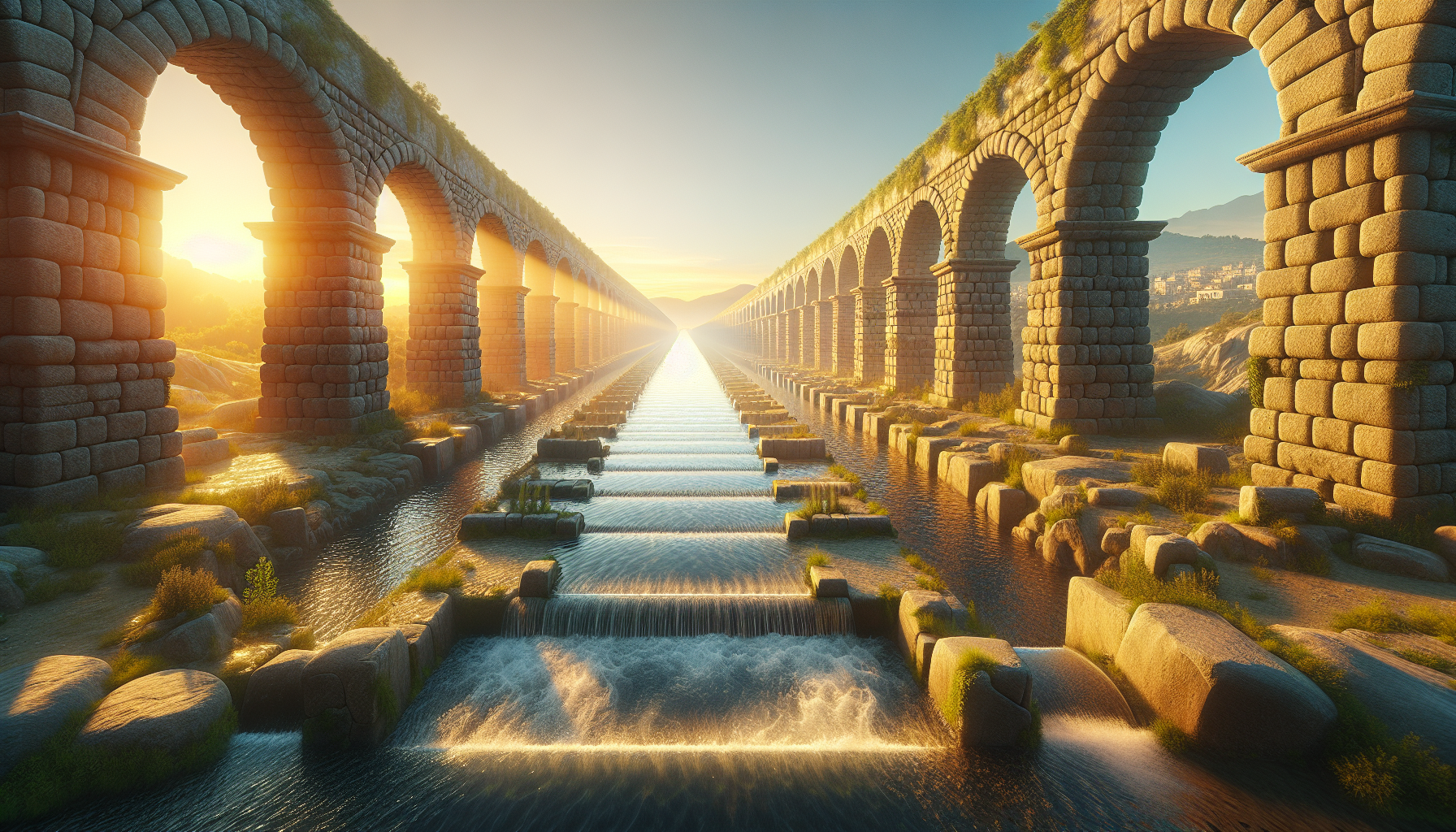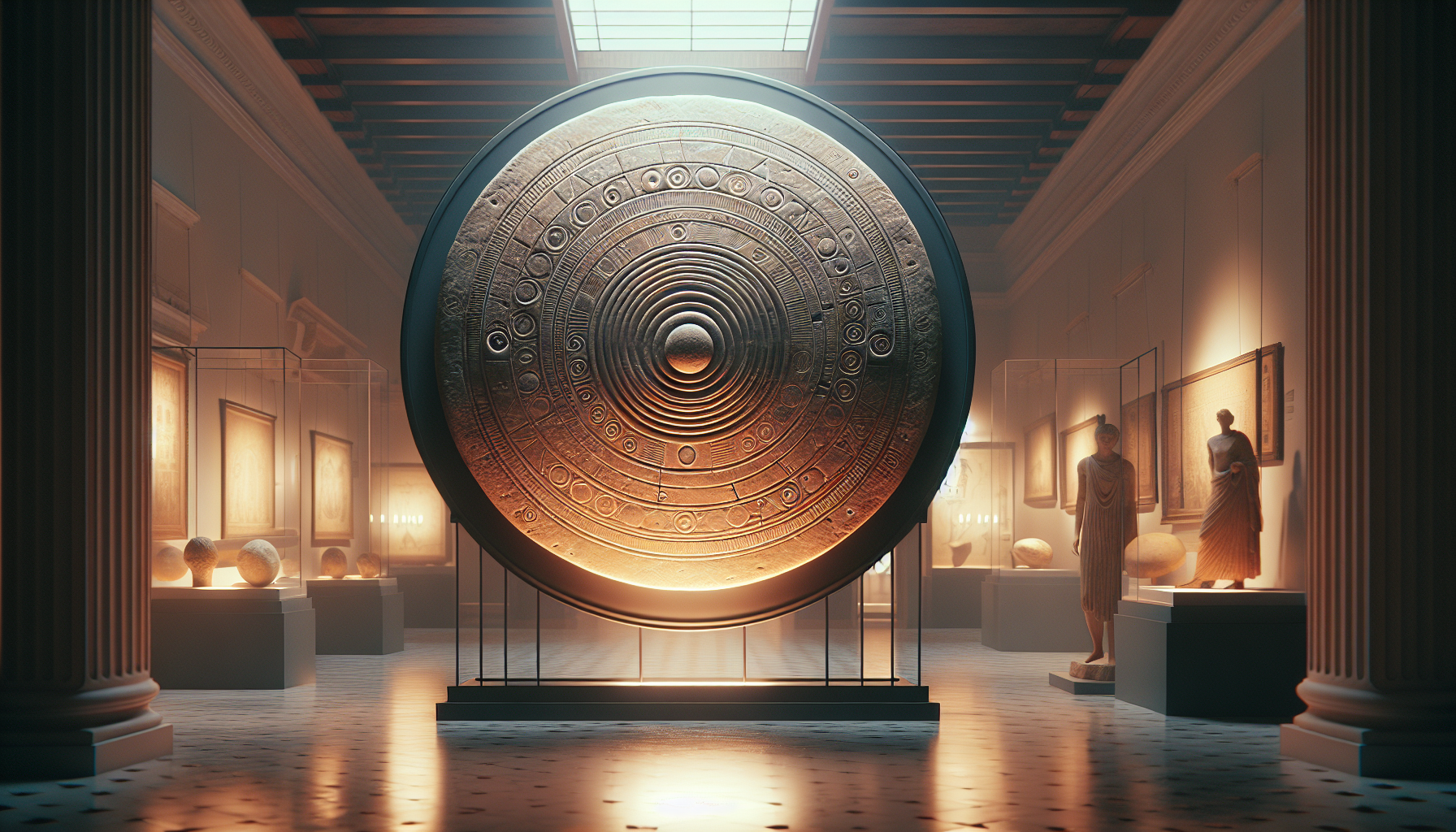Embarking on a historical journey through the ancient water management systems reveals the genius behind the world’s most advanced civilizations. From the well-planned aqueducts of Rome to the meticulously crafted stepwells of India, these engineering marvels are not only testaments to past skill but also lessons in sustainability and ingenuity for modern society.
Before delving deeper into the profound aspects of ancient water management, it’s essential to understand why water was so pivotal. The management of water resources served purposes from irrigation and flood control to spiritual and communal needs, illustrating a profound understanding of hydraulic engineering.
Core Systems and Technologies
The clever design and function of ancient water management systems provide a fascinating window into the technical prowess and strategic thinking of past civilizations. By examining several core systems and their technologies, we unlock a deeper understanding of their societal roles and technological sophistication.
Aqueducts and Water Channels
Roman Aqueducts: Engineering Marvels
Among the most eminent examples of ancient hydraulic engineering are the Roman aqueducts, remarkable for their ability to transport water over long distances and rough terrains. This technological feat was not just for practicality but also a symbol of Roman architectural and engineering prowess. Aqueducts like Aqua Claudia and the Segovia Aqueduct still stand as testament to the Roman mastery of civil engineering, skillfully combining form and function to meet the urban demands of their expansive empire.
The Subak System: Community-Driven Water Management
Far from the dry texts of history, the Subak system of Bali breathes life into the lush paddy fields of the island. This communal water management system, rooted in the Balinese philosophical concept of “Tri Hita Karana” (the three causes of happiness), is a blend of environmental wisdom, social equity, and spiritual beliefs. Subak is not just about irrigation; it’s a way of life, integrally supporting the rice terraces that are not only functional but also a UNESCO recognized cultural landscape.
Wells and Cisterns
Ingenious Stepwells of India
Moving to the architecturally stunning stepwells of India, these structures served multiple purposes: as social hubs, architectural marvels, and vital water storage systems. In places like Rajasthan and Gujarat, where the harsh climate imposes its will, stepwells were central to daily life and local lore. Chand Baori, one of the largest stepwells, is an incredible sight, combining utmost utility with intricate artistry, revealing the deep intertwining of culture and survival.
Ancient Persian Qanats: Lifelines of the Desert
In the arid landscapes of ancient Persia, now modern-day Iran, the qanat systems symbolize the adaptability and ingenuity of human ingenuity. These underground channels, hardly visible above ground, tapped into aquifers and brought water to dry surface via gravity, supporting agriculture and allowing settlements to flourish in otherwise inhospitable conditions. The meticulous planning and community effort involved in digging and maintaining these qanats underscore their importance in ancient Persian society.
By revisiting these ancient systems—each a reflection of its culture’s needs and technological capabilities—we gain not only insights into historical engineering and social structures but also appreciation for the ancient world’s complex relationship with water management. Each of these systems demonstrates a sophisticated approach to sustainability, offering lessons that resonate even in modern hydraulic engineering practices.
Geographical Mastery of Water
Systems Across Civilizations
Egyptian Ingenuity in the Nile Delta
In the arid landscapes of Egypt, water wasn’t just a crucial resource—it was the lifeblood of civilization. Ancient Egyptians, well aware of the ebbs and flows of the Nile, developed a sophisticated array of techniques to harness its blessings. From the construction of massive nilometers to measure the water levels of the Nile, to the intricate use of shadufs and water wheels for irrigation purposes, Egyptian engineers manipulated the river’s bounty to sustain their agricultural economy. This strategic mastery included the use of basins to trap flood waters during the rainy season, a practice that allowed for extended irrigation periods during drier months.
Water Wisdom of the Indus Valley Civilization
Turning to the Indus Valley, the urban centers of Harappa and Mohenjo-Daro stand as testimony to the advanced urban planning and water management systems of their time. It’s fascinating how these civilizations implemented extensive drainage systems and public baths, emphasizing not just utility but the importance of cleanliness and ritual. The precision with which these systems were built, ensuring proper slopes and using bricks of standardized sizes, highlights a deep understanding of engineering and urban sanitation.
Regional Innovations
Minoan Civilization: Pioneer Hydraulic Engineering
On the island of Crete, the Minoan civilization achieved feats of water management that were incredibly advanced for their time. Their systems included aqueducts, which transported water across mountains into cities, and sophisticated drainage systems that protected their structures from flooding. The Minoans were known for their luxurious palaces with fountains and baths, illustrating their capability to blend utility with aesthetic grandeur. A detailed study of their method reveals a highly organized approach to both urban planning and luxury, positioning them as early pioneers in hydraulic engineering.
The Hohokam Canals: Pre-Columbian Engineering Excellence
Across the ocean, in what is now the southwestern United States, the Hohokam civilization engineered an extensive system of canals. What’s striking is the magnitude and reach of their irrigation channels, which supported farming communities in an otherwise inhospitable environment. Employing only primitive tools, the Hohokam dug these canals through hard earth, moving soil and rocks without the aid of animal or mechanical power. This ingenuity provided a stable agricultural base, which underpinned the society and culture of the Hohokam for centuries.
Architectural and Cultural Significance
Ritualistic and Utilitarian Structures
Water Temples and Ritual Baths
Exploring the intertwining of spirituality with functionality, ancient civilizations often constructed water temples and ritual baths that went beyond mere utility.
- Bali’s Water Temples: In Bali, the Subak irrigation system not only coordinated agricultural activities but also served as a spiritual hub where water was ritually managed to appease the gods.
- Roman Baths: More than places for cleanliness, these were cultural hotspots in Rome where people socialized, conducted business, and engaged in political discourse.
Roman Baths and Greek Gyms: Communal Water Use
The communal use of water reflects a significant cultural artifact in ancient Europe.
- Roman Baths: Famous examples include the ruins of Bath in England and the Thermes de Cluny in Paris. These baths embodied a communal spirit where social classes intersected.
- Greek Gyms: Adjacent to springs and baths, these were essentially early wellness centers, promoting both physical and community well-being, demonstrating the importance of water as a communal asset.
Design and Artistry
The Aesthetic of Water in Mughal Architecture
In the grand palaces and gardens of the Mughal Empire, water was a central element of architectural design.
- Shalimar Gardens: Located in Lahore, featuring an intricate network of canals and fountains, these gardens highlight how water was used to enhance aesthetic appeal and create a serene atmosphere, serving both as marvels of hydraulic engineering and symbols of life and prosperity in arid landscapes.
Cambodian Water Temples: Hydraulic Serenity
The majestic Angkor Wat in Cambodia serves as a crowning example of how water management and religious symbolism were interwoven into the architectural tapestry of ancient societies.
- Architectural and Symbolic Design: The temple’s complex moat and reservoir system stabilized the structure’s foundation and mirrored the Hindu belief in the cosmic ocean, showcasing water’s tangible and transcendental qualities.
Through these architectural and cultural explorations, it becomes evident that water was not merely a physical resource but a pivotal element in cultural expressions and technological advancements. These ancient societies leveraged architectural ingenuity to elevate water from a utilitarian substance to a central figure in religious, social, and aesthetic domains, reflecting an elevated comprehension and appreciation that shaped their worldviews and daily lives.
Conservation and Sustainability: Ancient Techniques for Modern Times
Rainwater Harvesting: Lessons from Antiquity
Rainwater harvesting isn’t a novel concept but a time-tested strategy perfected by ancient civilizations. The ingenious ancient Roman cisterns, Mayan water reservoirs, and the grandiose stepwells in India stand as testaments to historical prowess in capturing and storing rainwater. These creations were not just functional but also beautifully integrated into the cultural fabric of the societies.
- Example: In arid regions like the Middle East, the Nabataean kingdom, known for Petra, implemented extensive rainwater harvesting and storage systems, supporting their thriving desert city.
Such age-old practices highlight sustainable methods that could potentially mitigate modern water scarcity issues if adapted thoughtfully.
Ancient Dams and Reservoirs: Managing the Extremes
Turning to more robust water management solutions, ancient societies demonstrated remarkable skill in constructing dams and reservoirs to control water flow and manage seasonal floods.
- Engineering Marvel: The Marib Dam in ancient Yemen, an impressive feat of engineering, supported agriculture and stabilized water supplies for centuries.
- Hydraulic Mastery: Similarly, Sri Lankan ancient reservoirs, or ‘tanks’ as locally known, were part of a sophisticated network providing water for irrigation and drinking.
These historical examples not only illustrate the capacity of ancient societies to handle extreme weather patterns but also offer valuable insights into resilience and adaptability that can inspire contemporary flood management strategies.
Legacy and Influence: Bridging Ancient and Modern Irrigation
Irrigation Canals Then and Now
The ancient world left behind a rich heritage of knowledge on water management. One of the primary examples is the Hohokam canals in the Southwestern United States, which demonstrate:
- Engineering Excellence: Native populations engineered extensive irrigation networks that are still admired for their sophistication today.
- Legacy of Innovation: These ancestral methods of directing water across landscapes to promote agriculture have evolved yet share a continuous thread with modern irrigation practices.
The Global Impact of Ancient Hydraulic Practices
The ripple effect of ancient water management practices extends far beyond their immediate geographic and temporal locales. Techniques such as the qanat systems of ancient Persia, or the intricate aqueducts of the Roman Empire, have shaped modern hydraulic engineering and water conservation practices.
- Influential Systems: The qanat systems of ancient Persia and the aqueducts of the Roman Empire
- Modern Applications: These ancient systems inform contemporary projects, using principles like gravity flow in designs and promoting sustainable water usage.
By studying these ancient practices, engineers and policymakers today can integrate sustainable ancient wisdom with modern technology to address the pressing water management issues facing our global community.
In weaving the rich tapestry of ancient water management practices into the fabric of modern environmental strategies, we not only pay homage to the remarkable ingenuity of our ancestors but also forge a path toward more sustainable and resilient water use practices for future generations.
Hydraulic Machinery and Innovations
Water Wheels and Norias: Powering Ancient Societies
Let’s explore how ancient civilizations not only survived but thrived by ingeniously utilizing the power of flowing water. Long before the advent of modern engines and electricity, ancient engineers tapped into this natural resource with the help of water wheels and norias, critical tools for agricultural and urban development.
- Water Wheels: These iconic inventions played a crucial role in various ancient hydraulic civilizations, from Mesopotamian irrigation to the Roman Empire. By harnessing river flow, these wheels transformed mechanical power into essential energy for grinding grain and lifting water—essentially putting the river to work!
- Norias: Predominantly used in regions like ancient Syria and Persia, norias were large wheels that lifted water to aqueducts or directly into irrigation canals. They were particularly essential where water sources were lower than the fields, enabling water to ‘travel uphill’ and transforming arid zones into fertile lands.
Ancient Filtration Systems: Purity and Practicality
Now, let’s consider the ancient approaches to water purity. Contrary to assumptions, ancient civilizations took significant steps to ensure their water was not only available but also drinkable.
- Filtration Techniques:
- In ancient Egypt, sand and gravel served as primitive filters to cleanse Nile water used for drinking and cooking.
- The Greeks and Romans used settling basins and constructed wetlands that both beautified and purified, filtering impurities and creating serene water landscapes.
Engineering and Construction Techniques
The Construction of Roman Aqueducts
An in-depth look at Roman aqueducts reveals the precision and advanced engineering of ancient Rome:
- Planning and Route Selection: Roman engineers meticulously chose aqueduct routes to maintain a steady downhill flow, crucial for regulating water velocity and volume.
- Construction Materials: Built with stone, mortar, and concrete for their longevity and ease of maintenance.
- Intricate Calculations: Designed meticulously to minimize leakage and maximize flow, ensuring a steady water supply for public baths, fountains, and residences. Structures like Aqua Claudia and Aqua Marcia highlight the monumental scale and the advanced hydraulic planning of Roman engineering.
Mastering Material and Terrain
Ancient engineers excelled in adapting construction to local materials and geographic conditions:
- Adaptation in Varied Terrains:
- In the mountainous regions of Peru, the Incas tailored polished stone channels to navigate through the Andes, designed to withstand earthquakes.
- In arid regions like Persia, qanats and underground aqueducts minimized water evaporation by keeping the flow hidden from the sun.
Through their functionality and respect for the local environments, these ancient systems did more than transport water; they represented a harmony between human innovation and the natural world. Reflecting on these methodologies today offers valuable insights into sustainable water management practices that could benefit the modern world.
Cross-Cultural Exchanges and Development
Influence Across Borders
“Water Management: A Cultural Exchange” paints a vivid tapestry of how ancient civilizations weren’t silos of innovation but interconnected entities that shared, borrowed, and adapted water management technologies from each other. This flow of ideas was crucial for the advancements in hydraulic engineering we marvel at today.
Historically, the Romans were renowned for their aqueducts, bringing water into cities from afar, a technique they expanded upon as they encountered other cultures with similar needs but different solutions. For instance, while extending their empire, they encountered the Persian qanat systems, underground channels used to transport water in arid regions. The integration of these systems illustrates not just an exchange but an evolution of engineering knowledge that underscored the Roman empire’s expansion.
Similarly, the stepwells of India, which were multifunctional structures serving both spiritual and practical purposes, influenced architectural and engineering practices far beyond the Indian subcontinent. As traders from the Middle East and later Europeans came into contact with these intricate structures, ideas about water management and architectural integration began to reflect in their own distant water systems.
Furthermore, the influence of Egyptian water management techniques, particularly their use of the Nile’s floodwaters for irrigation, spread through Greek and later Roman territories, showcasing how crucial practices in one civilization could propagate across borders, enhancing agriculture and thus the sustenance of entire populations.
Integration into Local Traditions
“Sacred Springs and Divine Waters” dives deeper into how water wasn’t just a physical necessity but also held a profound spiritual and cultural significance, integrating into the local traditions of various civilizations. Across the globe, water sources were often deified or considered sacred, playing central roles in religious practices and local folklore.
In Bali, the Subak system isn’t merely about irrigation but is deeply tied to the Balinese concept of Tri Hita Karana, which embodies the spiritual relationship between humans, earth, and the gods. This religious framing helped sustain and govern the intricate water management systems which have prevailed for centuries.
In ancient Greece, sources like the famous Castalian Spring at Delphi were considered to hold mystical powers, integral to the religious practices and rituals of the time. These cultural significances attributed to water influenced not only local practices but also the architectural and engineering choices made, from the construction of elaborate fountains to the intricate positioning of baths and ritual sites in relation to these water sources.
The global impact of these water management systems is a testament to how ancient societies were not merely surviving but thriving by ingeniously harnessing and venerating this critical resource. This complex tapestry of technological innovation influenced by, and woven into, the cultural fabric and spiritual life across civilizations, provides profound insights into the sophisticated understanding and respect our ancestors had for nature’s most precious commodity: water.
Unearthing Past Wisdom: The Continuous Journey in Water Management Studies
Archaeological Insights
Digging into the layers of the past, modern archaeology plays an invaluable role in reconstructing the intricate frameworks of ancient water management systems. Each excavation site is a treasure trove, revealing subtle details and groundbreaking techniques used by early civilizations. From the Roman aqueducts to the sophisticated stepwells of India, unearthed artifacts and structures provide a clearer picture of how different cultures tackled the challenge of water distribution and conservation.
In regions like the Middle East, the qanat systems—ingeniously designed underground canals—have been brought to light through arduous archaeological efforts. These systems spread far beyond Persia, suggesting a rich exchange of hydraulic knowledge among ancient civilizations. Similarly, in the arid landscapes of the American Southwest, the remnants of Hohokam canals hint at a once-thriving culture deeply attuned to water’s critical role in survival and societal development.
Archaeologists rely on a variety of advanced technologies such as:
- Ground-penetrating radar
- Digital mapping tools
These tools are used not only to locate but analyze the construction and maintenance of these systems. This integration of ancient wisdom with modern technology opens up new layers of understanding, showing us the complexities of water management practices that sustained large populations and cultivated prosperous societies.
Prospects for Future Research
Looking forward, the domain of water-related archaeology holds exciting potential for new discoveries and insights. As technology evolves, so does the scope of what we can learn about our ancestors’ hydraulic innovations. Future research is poised to delve deeper into the unexplored urban centers and possibly unearth whole networks of water management that have been lost to time.
One promising area involves the study of climate adaptation strategies of the past. By examining how ancient societies adjusted their water management techniques in response to changing environmental conditions, modern researchers can glean valuable lessons for addressing today’s global water crises. Furthermore, interdisciplinary approaches involving hydrologists, climatologists, and historians are crucial in piecing together the full spectrum of ancient hydraulic engineering practices and their impact on society.
The continuous exploration of ancient water management systems not only satisfies intellectual curiosity but also equips today’s engineers and policymakers with time-tested strategies to tackle current and future challenges in water conservation and distribution. By bridging the gap between past and present, archaeology not only honors our ancestral ingenuity but also propels us toward more sustainable and informed water management practices.
As we venture further into this fascinating interplay of history and technology, the ancient channels, wells, and aqueducts remind us that our quest for knowledge is as flowing and replenished as the water sources our forebears so skillfully harnessed.




